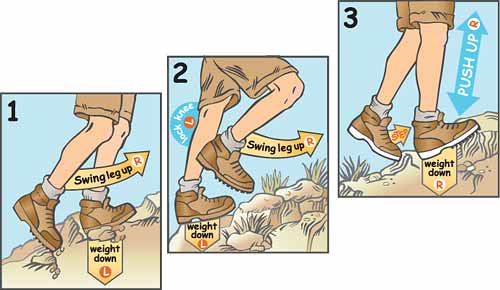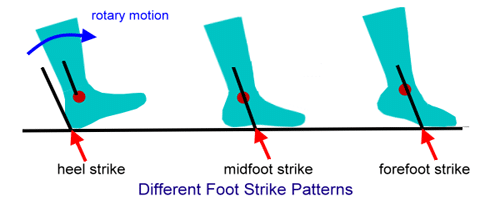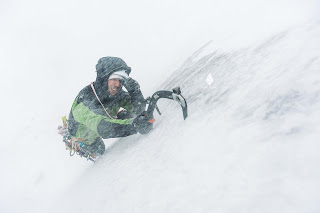Hiking For Climbers: 11 Tips I've Learned To Be More Efficient
 |
1) Small steps below the waist: This is a tip I learned from running. Instead of slow long strides, make quick short ones, never passing too far from your center of mass (your hips). This uses less energy for balancing.
2) Look up and keep your eyes down the trail: You may have a tendency to look down and just "grind" but keeping your eyes up will make it easier to maintain an upright posture. It's harder to breathe if you're bent over.
 |
| Notice how on off-camber slopes, using a shorter uphill pole can help... (photo from theinertia.com) |
4) Proper hydration/nutrition: Nutrition For Climbers (by Marisa Michael) says to aim for about 8oz. of water every hour. Calorie needs will vary, but experiment (aiming for excess at first) till you find what works.
5) Adjust your pack properly: Keep the hip belt above the waist. Tighten your chest strap to prevent the pack from falling away from your back.
6) Load your pack properly: Load heavy things like your rope and rack at the bottom, inwards towards your back (to prevent your pack from leveraging away from you). Keep the harness, helmet, shoes, chalk, etc. near the top.
7) ARCing intensity: Just like the popular aerobic endurance training method, stay in a low-intensity state. There's no reason to waste energy walking to the cliff. To keep it the right intensity, be able to talk or breathe through your nose.
 |
| The Rest Step (photo from Scouting Magazine) |
8) The Rest Step: No breaks is faster but... you don't want to be too tired. A happy medium is the rest step. Slow your pace and lock out your downhill knee. Remember though, it isn't good for a consistent pace, so use it only when you need a break.
9) Don't die on the way down: Keep the quick short steps, use your poles, and lean back slightly when you start going downhill. Save your knees the pain of running down. |
| photo from runnersconnect.net |
11) Find the right partner/pace: If your partners are slave drivers like mine don't feel shame in asking them to slow down. Get in front and set the pace, and be conscious of their ability. One time, on the way down from some multi-pitch routes, I wanted to set the pace. I ran to get in front of my partner, but he started running too. We kept it up for a bit, until I said, "Dude, what the heck are we doing!?" Communicate!

Regarding 6), my opinion is that loading a pack properly differs according to terrain. On an uphill slog, heavier gear on the top and near your back, helps to push your center of gravity forward, with the downside being that this setup introduces more sideways sway. On downhill, having your heavier objects near the bottom (and close to your back) may help with balance. In practice I do neither of these, just pack less!
ReplyDelete